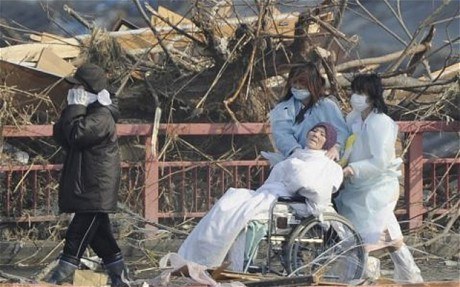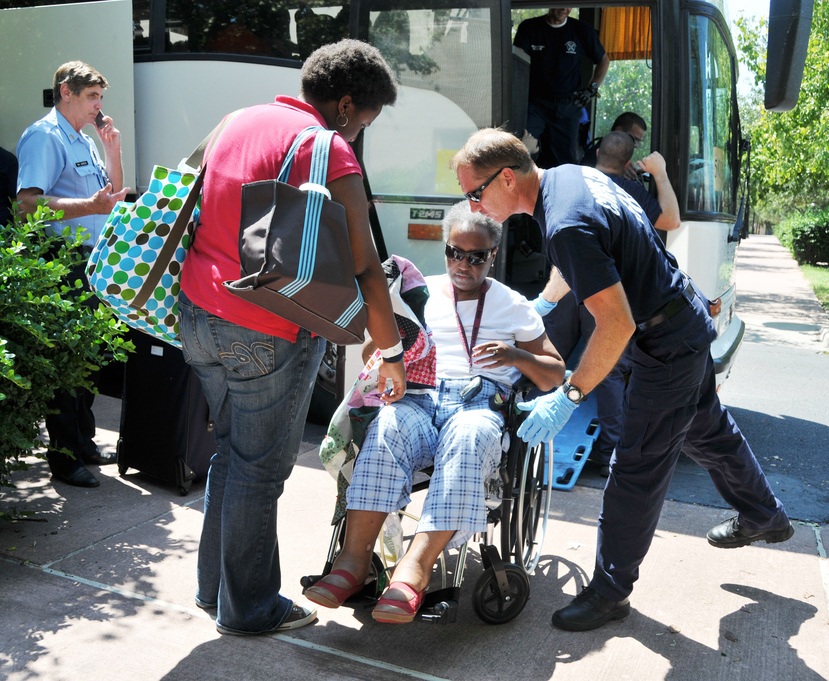
A patient in a wheelchair is helped by attendants as they evacuate from a tsunami-affected hospital at Otsuchi, northeastern Japan Photo: AP
Folks with functional needs have been historically under-served before a disaster strikes (think: "notice event" like a hurricane versus a "no-notice" event like an explosion).
As a result, a disproportionate amount of effort must be taken to evacuate them to a better place after the disaster strikes.
During virtually every large hurricane in the last 10 years, responders across the country have had to provide sometimes herculean effort to meet the needs of those that can not help themselves.
Before someone accuses me of being callous, it's actually the opposite. If we care about the part of our society with functional needs - and we should - then we should also care enough to address their needs in a meaningful way on our timetable instead of Mother Nature's timetable.
Functional Needs Populations are defined as those whose members may have additional needs before, during and after an incident in functional areas, including but not limited to: maintaining independence, communication, transportation, supervision, and medical care.
After Superstorm Sandy (2012) started lashing the Northeast, there were several occupied nursing homes that were reported to be without power and without a plan.
As the eye of Hurricane Gustav (2008) started coming ashore in Southern Louisiana, scores of wheelchair-laden residents were sitting on a tarmac waiting for someone to fly them (the roads were already closed due to the storm surge) to safety.

A Corpus Christi, Texas, firefighter assists a resident with special needs into a bus that will take her and her family to a shelter in San Antonio in advance of Hurricane Ike's landfall in 2008. Photo courtesy of Patsy Lynch/FEMA
All of those situations still require responders to marshal forces to go evacuate them, which is what we do of course.
However unlike loading a typical (as in, non-special needs) family of four into boat, many folks with functional needs require oxygen, hospital beds, wheelchairs or other special assistance.
The resources (people and equipment) needed to pull that off are the same ones that could be assisting 5 times that many people in an area that is also affected.
Remember this mantra:
Do the Most Good for the Most People, as Quickly and Safely as You Can.
That statement is one of the building blocks of most of my search and rescue classes and is woven into the fiber of my being.
And spending an hour helping 1 person is not as important as spending an hour helping 4.
So what's my point? More needs to be done, in an informed way, to evacuate people with functional needs prior to a notice event so they don't have to recover from a disaster from within a disaster (a big no-no, by the way).
However, the pendulum of addressing the problem - similar to the PETS Act that requires us to evacuate companion animals - now runs the risk of swinging too far to the other side of being over-engineered.
If we relocate every resident - with or without functional needs - every time a beer car blows over near the Gulf of Mexico, we will end up with a gargantuan number of displaced folks along with all of the friction that comes with large-scale evacuations.
During Hurricane Rita in 2005 over a million people tried to evacuate the Galveston Texas area ... can you say traffic snarl?
Before Hurricane Isaac (2012) a small and cash-strapped parish in Louisiana evacuated thousands of residents in anticipation of a Katrina-style levee breach ... which never came. The parish was out $6 million bucks.
Too little or too much can be a burden ... and relying on cues from Mother Nature is a gamble at best. So what does a community do?
In Lima Ohio, they recently set up a functional needs registry for evacuation assistance. A pre-plan if you will that identifies those people who need (or want?) evacuating.
Except it's voluntary.
Most folks don't pre-plan their disaster response very well already so is this going to be any different? Like the voluntary cellphone signups to be notified of community emergencies, most have very low participation. So who thinks this is gonna work?
These articles usually end with a solution ... but a clear answer to this quandary is a bit elusive.
If one of my clients asked me to help frame a response I would always start with framing the objective first.
No government agency (in America anyway) will say that there is such a thing as an "acceptable loss" so I'll assume that their objective would be to save everyone early and often ... until they saw the price tag.
A typical government solution is to sock more money away for an emergency that threatens its taxpayers, er, I mean people, yet most money trees are running dry for such pie in the sky events.
So perhaps they should bolster their public/private partnerships to cultivate and train existing community resources to step up during a time in need, whenever that need arises?
